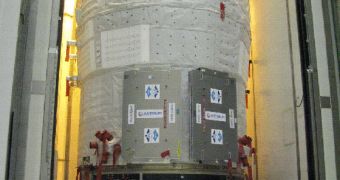In anticipation of a mid-February launch, engineers at the European Space Agency (ESA) announce the assembly of the organization's next unmanned cargo ship to its heavy-lift delivery system. The team in charge of the take-off efforts is spread on four continents.
The cargo carrier in question is the Johannes Kepler Automated Transfer Vehicle (ATV), the second such spacecraft constructed by the European organization. It is scheduled to fly to the International Space Station (ISS) to deliver tons of various supplies.
It will be flown to low-Earth orbit (LEO) aboard an Ariane 5 rocket, the workhorse used by the Europeans for most of their launches. At this point, the two spacecraft are scheduled to blast off at 22:07 GMT (23:07 CET), on February 15.
As usual, ESA will use its French Guyana-based facilities for the job. The ATV, its cargo and its rocket are already delivered to the Kourou Spaceport, in South America, where they are being integrated.
According to an official statement from ESA, a large part of the payload that will be taken to LEO has already been placed inside Johannes Kepler's pressurized cargo hold. The vehicle also received its fuel.
Currently, all systems aboard are being checked and double-checked. The spacecraft is due to remain in space for eight days, trailing the ISS until their orbits match. ESA officials estimate that the two will meet up with each other on February 23.
This is just one day before the space shuttle Discovery is due to launch from the Kennedy Space Center (KSC), in Florida. The arrival of the orbiter will conclude a busy month, in which four space vehicles made their way to the station.
The Japanese HTV2 was the first, followed by the Russian built Progress 41 space capsule. Johannes Kepler will be the third unmanned spacecraft to deliver tons of water, food, scientific experiments, propellant and personal items for the Expedition 26 crew in orbit.
“There is an incredible amount of hard work being done in these final weeks by teams from ESA, CNES, Arianespace and our partners. It’s gratifying to see such dedication to making Johannes Kepler ready for flight,” explains the ESA ATV program manager, Nico Dettmann.
“The operations teams from ESA, CNES and our industrial partners have worked very hard to make sure everything is ready, including many long hours of training to be ready in case of any contingencies,” adds ESA official Alberto Novelli.
“We are ready for ATV’s flight and everyone is keen to get to liftoff,” adds the expert, who is the ISS Operations Manager at the European organization, Space Fellowship reports.

 14 DAY TRIAL //
14 DAY TRIAL //